Money of the Kingdom of Heavenly Peace
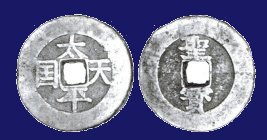 Few people, if asked today, could identify the Kingdom of Heavenly Peace, tell you where it was located, or how or why it came into existence. The Kingdom of Heavenly Peace, founded in 1850, started as a noble experiment with great promise, which soon turned into outright rebellion against the Chinese Empire. The movement went terribly wrong, ultimately claiming the lives of 25 million Chinese before government troops, aided by Western forces, restored order.
Few people, if asked today, could identify the Kingdom of Heavenly Peace, tell you where it was located, or how or why it came into existence. The Kingdom of Heavenly Peace, founded in 1850, started as a noble experiment with great promise, which soon turned into outright rebellion against the Chinese Empire. The movement went terribly wrong, ultimately claiming the lives of 25 million Chinese before government troops, aided by Western forces, restored order.
During their fifteen year civil war the T'ai P'ing rebels, as they were called, formed a government which included an army, a civilian civil service bureaucracy, treasury and even a postal system of their own. This article studies the money of the T'ai P'ing rebels including both coins and bank notes. Few specimens of either survive today. The coin issues are varied and interesting. The bank notes, although referenced in various old numismatic books, are completely unknown to Westerners, have never been cataloged, and to my knowledge appear here for the first time.
Click to download PDF here.
Shanghai's Wartime Emergency Money
 This is the story of a little known aspect of China's history and an oft neglected area of numismatics. The setting of this article is the Chinese city of Shanghai and the year is 1939. Dire things are about to happen which will drastically change the way the city goes about its business.
This is the story of a little known aspect of China's history and an oft neglected area of numismatics. The setting of this article is the Chinese city of Shanghai and the year is 1939. Dire things are about to happen which will drastically change the way the city goes about its business.
To set the stage the author takes you through the years leading up to 1937, when the Japanese invaded China prior to World War II. After abandoning the silver standard in 1935, the Chinese government set about to unify and stabilize both coins and bank notes. After working for awhile, inflation set in due to the war ultimately driving Shanghai's merchants to the use of emergency money to keep commerce flowing.
Click to download PDF here.
A Monetary History of German East Africa
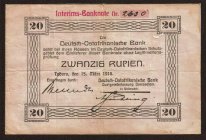 From time immemorial Europeans sought to explore and exploit foreign lands for their own benefit. The wealth of these lands, of course, flowed to the conquering power doing little for the natives who were thus "colonized". By the 1860s European attention was drawn to the continent of Africa, then in the process of discovery.
From time immemorial Europeans sought to explore and exploit foreign lands for their own benefit. The wealth of these lands, of course, flowed to the conquering power doing little for the natives who were thus "colonized". By the 1860s European attention was drawn to the continent of Africa, then in the process of discovery.
Britain, France, Germany, Italy, Belgium, Portugal and Spain all laid claim to African territory. This article explores how Germany came to colonize German East Africa, giving a detailed account of all coin issues - both governmental and private. German East Africa became a very profitable and well ordered colony, with an outstanding monetary system of its own. When World War I came along, the colony found itself isolated from the mother country, unable to rely on help from outside quarters. Relying upon national pride and a great deal of ingenuity, the Germans were able to resist the British invasion until the homeland capitulated in 1918.
Of particular interest are the German East African bank notes which offer an infinite variety of issues which illustrate the will and resolve of the German and native Askaris to win the war and keep their colony intact.
Click to download PDF here.
Some Russian Bank Note Issues Associated with the Chinese Eastern Railway
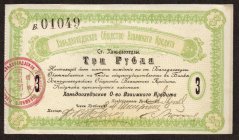 Collectors occasionally encounter a set of Russian language bank notes dating from the Bolshevik Revolution, which have been overprinted with a Chinese hand-stamp. Are these notes Russian, or are they Chinese? Who issued them and where? ... and for what purpose? This article reveals the research undergone to reveal the answers.
Collectors occasionally encounter a set of Russian language bank notes dating from the Bolshevik Revolution, which have been overprinted with a Chinese hand-stamp. Are these notes Russian, or are they Chinese? Who issued them and where? ... and for what purpose? This article reveals the research undergone to reveal the answers.
Click to download PDF here.
Some Previously Unlisted Bank Notes of the German Independent States
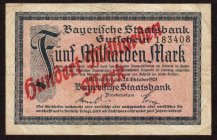 Not to be found in any catalog I am aware of are a series of German bank notes which belong to the German "Independent States". Germany, prior to unification consisted of four kingdoms, six grand duchies, five duchies, seven principalities and three free cities. When Wilhelm I of Prussia was declared the first German emperor by the Reichstag in 1871, not everyone was wildly enthusiastic. The chief dissenters were the southern kingdoms of Bavaria and Wurttemberg and the Duchy of Baden. As a concession for these states to join the German Empire, the Reischstag granted them concessions, which included to right to continue issuing their own stamps, coins and paper money.
Not to be found in any catalog I am aware of are a series of German bank notes which belong to the German "Independent States". Germany, prior to unification consisted of four kingdoms, six grand duchies, five duchies, seven principalities and three free cities. When Wilhelm I of Prussia was declared the first German emperor by the Reichstag in 1871, not everyone was wildly enthusiastic. The chief dissenters were the southern kingdoms of Bavaria and Wurttemberg and the Duchy of Baden. As a concession for these states to join the German Empire, the Reischstag granted them concessions, which included to right to continue issuing their own stamps, coins and paper money.
This article explores some of these interesting and oft overlooked issues.
Click to download PDF here.
A Numismatic History of Portugal's " War of the Two Brothers "
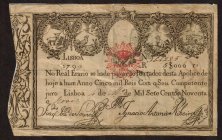 This article describes the fight between two opposing monarchs, each of whom issued bank notes in support of his cause. Fleeing his homeland to the safety of the Portuguese colony of Brazil to escape the Napoleonic War, king Joäo VI placed his eldest son, Pedro, on the throne of Brazil in order to keep the colony in the Braganca family. Here the son ruled as Pedro I, emperor of Brazil. After the Napoleonic War, Joäo VI returned to Portugal, where he died in 1826. In the meantime Brazil declared its independence from Portugal in 1822. The ruling liberals favored Pedro as the successor over his brother Miguel, placing Pedro on the throne of Portugal as Pedro IV.
This article describes the fight between two opposing monarchs, each of whom issued bank notes in support of his cause. Fleeing his homeland to the safety of the Portuguese colony of Brazil to escape the Napoleonic War, king Joäo VI placed his eldest son, Pedro, on the throne of Brazil in order to keep the colony in the Braganca family. Here the son ruled as Pedro I, emperor of Brazil. After the Napoleonic War, Joäo VI returned to Portugal, where he died in 1826. In the meantime Brazil declared its independence from Portugal in 1822. The ruling liberals favored Pedro as the successor over his brother Miguel, placing Pedro on the throne of Portugal as Pedro IV.
The conservatives had other plans however, encouraging Miguel to usurp the throne in 1828 where he ruled as Miguel I until 1834. The two factions fought it out on both sides of the Atlantic until Miguel was exiled and Pedro IV restored as the legitimate heir. The "War of the Two Brothers" impacted the currency of both Portugal and Brazil, as discussed in this article.
Click to download PDF here.
Cast Coinage of the "Ming Rebels"
 The Ming dynasty lasted from 1368 to the year 1644 when China was over-run by barbarians from the north calling themselves Manchus. These fierce horsemen quickly conquered the decadent Ming, in turn establishing their own Ch'ing dynasty, China's last experiment with imperial rule.
The Ming dynasty lasted from 1368 to the year 1644 when China was over-run by barbarians from the north calling themselves Manchus. These fierce horsemen quickly conquered the decadent Ming, in turn establishing their own Ch'ing dynasty, China's last experiment with imperial rule.
The Ming court did not die easily, however, as one usurper after the other tried, for forty years, to reestablish Ming rule. Collectively these men were known as the "Ming Rebels". Each prince and warlord had his own court, army and bureaucratic following, setting up bases in various parts of China from which to overthrow the Ch'ing. Some enjoyed significant success while others did not. All, however, issued their own cast coinage for use in the areas they temporarily held. The coins are well executed, beautiful, specimens and are reasonably easy to acquire even today.
This article tracks the history of each rebel revealing both treachery and brutality in the attempt to eliminate the remaining vestige of loyalty to the Ming dynasty. The coin issues of each Ming Rebel are described in detail.
Click to download PDF here.
The Money of Communist China - Part I
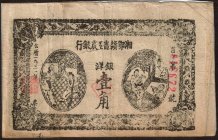 Prior to 1949 the People's Republic of China did not exist as such. In its place, commencing in 1927, was a Communist party which controlled scattered areas throughout China known as "soviets". These bases underwent many changes; first at the hands of victorious Nationalist armies, and after 1937, the Japanese invaders. These early Communists were self sufficient in every way. This included the manufacture and circulation of their own currency - including both coins and paper money. Driven out of their southern soviets by Chang Kai-shek's Nationalist army in 1934, the Communists fled north on their Long March to escape annihilation and to save their cause. There they stayed to fight the Japanese, and after World War II, to engage in all out civil war against the Nationalists for control of all of China.
Prior to 1949 the People's Republic of China did not exist as such. In its place, commencing in 1927, was a Communist party which controlled scattered areas throughout China known as "soviets". These bases underwent many changes; first at the hands of victorious Nationalist armies, and after 1937, the Japanese invaders. These early Communists were self sufficient in every way. This included the manufacture and circulation of their own currency - including both coins and paper money. Driven out of their southern soviets by Chang Kai-shek's Nationalist army in 1934, the Communists fled north on their Long March to escape annihilation and to save their cause. There they stayed to fight the Japanese, and after World War II, to engage in all out civil war against the Nationalists for control of all of China.
Part I describes the coins and paper money used by the early soviets from 1927 to 1934, which period ended in the Long March north to Shensi province.
Click to download PDF here.
Money of Communist China - Part II
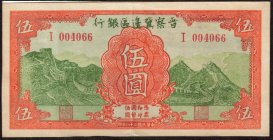 Part II describes the money of the Communist Base Areas during the War of Resistance against the Japanese (1936-1945)
Part II describes the money of the Communist Base Areas during the War of Resistance against the Japanese (1936-1945)
Click to download PDF here.
Money of Communist China - Part III
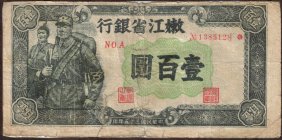 Part III describes the money used in the Communist
Part III describes the money used in the Communist
" Liberated Areas " during the civil war with the Chinese Nationalists (1945-1949).
Click to download PDF here.
The Significance of Stamps Used on Bank Notes
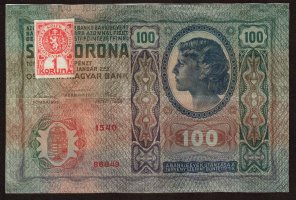 Every collector, sooner or later, runs into a bank note or two with adhesive stamps affixed to them. This article, originally written by Dr. Arnold Keller, the dean of paper money collectors, explores the various reasons governments altered the original use of bank notes by affixing stamps thereto. Some stamps were attached to merely authenticate the value of the note itself after a change in government, other uses had tax implications, while still other applications were efforts to alter the economy of a region or whole country. Many of these schemes were ingenious beyond belief, and many of them actually worked!
Every collector, sooner or later, runs into a bank note or two with adhesive stamps affixed to them. This article, originally written by Dr. Arnold Keller, the dean of paper money collectors, explores the various reasons governments altered the original use of bank notes by affixing stamps thereto. Some stamps were attached to merely authenticate the value of the note itself after a change in government, other uses had tax implications, while still other applications were efforts to alter the economy of a region or whole country. Many of these schemes were ingenious beyond belief, and many of them actually worked!
All examples of stamps found on bank notes which are known to the author are enumerated in this article. Undoubtedly there are other examples. Fellow collectors who know of other examples are invited to share their knowledge with us.
Click to download PDF here.
Some Anomalies Found on Greek Bank Notes
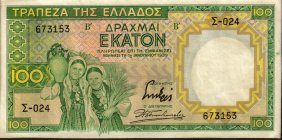 From a numismatic perspective Greek bank notes of the period 1939 to the end of World War II are interesting as they contain a number of anomalies not found elsewhere. These include error notes, overprints, design changes on the same note, watermarks, under-print variations and above all, the phenomena of identical series and series numbers which are commonly found on notes of the German occupation series. Some of these abnormalities can be explained, while others still remain a mystery.
From a numismatic perspective Greek bank notes of the period 1939 to the end of World War II are interesting as they contain a number of anomalies not found elsewhere. These include error notes, overprints, design changes on the same note, watermarks, under-print variations and above all, the phenomena of identical series and series numbers which are commonly found on notes of the German occupation series. Some of these abnormalities can be explained, while others still remain a mystery.
Click to download PDF here.
German Railroad Notes of the 1923 Hyperinflation
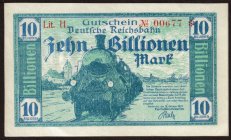 Germany offers many diverse collecting opportunities for coin and paper money enthusiasts. Among these, its varied paper money issues contain numerous areas of specialization for the collector. One such area comprises the banknotes of the German national railroad (the Deutsche Reichsbahn), and its regional offices (the various Reichsbahndirektions). These notes were issued, under law, as an emergency expedient at the height of the post World War I inflation. For those who have a passion for trains and railroading, these notes hold a special interest.
Germany offers many diverse collecting opportunities for coin and paper money enthusiasts. Among these, its varied paper money issues contain numerous areas of specialization for the collector. One such area comprises the banknotes of the German national railroad (the Deutsche Reichsbahn), and its regional offices (the various Reichsbahndirektions). These notes were issued, under law, as an emergency expedient at the height of the post World War I inflation. For those who have a passion for trains and railroading, these notes hold a special interest.
Click to download PDF here.
Japanese Sponsored Coin and Bank Note Issues for the Occupied Regions of China
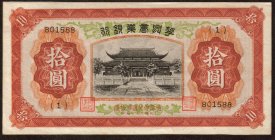 Occasionally, even today, one will encounter in a dealer's junk box or stock, a coin or piece of paper money whose origins lay in Japan's conquest and occupation of China (1937-1945). In order to administer such a vast country, Japan divided China up into administrative regions, each with its own financial management.
Occasionally, even today, one will encounter in a dealer's junk box or stock, a coin or piece of paper money whose origins lay in Japan's conquest and occupation of China (1937-1945). In order to administer such a vast country, Japan divided China up into administrative regions, each with its own financial management.
The coin and bank note issues of these Japanese "puppet" autonomous regions should not be viewed in isolation, as it is the totality of the story that is interesting. Coin collectors, perhaps, are aware of the coins, while bank note collectors are familiar with the various note issues. To appreciate the "total picture" as to what really transpired during the Japanese occupation, they must be viewed together.
Click to download PDF here.
A Monetary History of the Former German Colony of Kiaochou
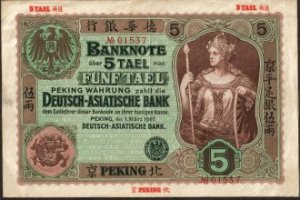 The defeat of China after two Opium Wars left the Ch'ing Dynasty weak and disorganized. European powers were quick to exploit this weakness. Both Britain and France placed exorbitant demands upon China in the form of monetary indemnity for expenses they had incurred during the wars, and for the outright concession of Chinese territory.
The defeat of China after two Opium Wars left the Ch'ing Dynasty weak and disorganized. European powers were quick to exploit this weakness. Both Britain and France placed exorbitant demands upon China in the form of monetary indemnity for expenses they had incurred during the wars, and for the outright concession of Chinese territory.
Sensing this weakness, other European powers were quick to seize territorial concessions and to set up their own 'spheres of influence' within China for commercial purposes. This is the story of how Germany became a colonial player in the China trade.
Click to download PDF here.
Siege Notes - Windows to the Past - Part I
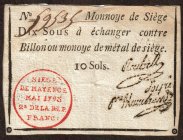 Siege warfare has been practiced by invading armies since time immemorial. As a form of warfare it attained its highest degree of development in Europe from the late 1500s until the introduction of more powerful weapons made the siege of towns and cities unnecessary. Throughout the years, a by-product of this type warfare was the production of "siege notes", paper money of necessity, to be used to sustain commerce for those under siege.
Siege warfare has been practiced by invading armies since time immemorial. As a form of warfare it attained its highest degree of development in Europe from the late 1500s until the introduction of more powerful weapons made the siege of towns and cities unnecessary. Throughout the years, a by-product of this type warfare was the production of "siege notes", paper money of necessity, to be used to sustain commerce for those under siege.
Part I discusses siege techniques and the sieges of Leyden, Lyon, Colberg, Mayence, Mantova, Erfurt, Zara, Palmanova and Osoppo, all of which issued siege notes during their defense.
Click to download PDF here.
Siege Notes - Windows to the Past - Part II
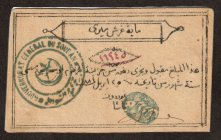 Part II discusses the sieges of Khartoum in Africa, famous for the defeat of the British forces under General Gordon; Koffyfontein, O'okiep and Mafeking during the Boer War and finally the siege of the Ottomans in their mountain fortress at Scutari in modern day Albania.
Part II discusses the sieges of Khartoum in Africa, famous for the defeat of the British forces under General Gordon; Koffyfontein, O'okiep and Mafeking during the Boer War and finally the siege of the Ottomans in their mountain fortress at Scutari in modern day Albania.
Click to download PDF here.
Ancient Chinese Cash Notes - the World's First Paper Money - Part I
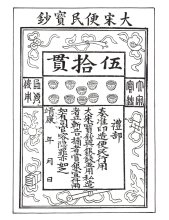 China has had a long and diversified numismatic history. From the dawn of antiquity onward, early Chinese traders used money in one form or another. It was not long after the Chinese invention of paper that the first paper money came into existence, making it the oldest paper money to be found in the world.
China has had a long and diversified numismatic history. From the dawn of antiquity onward, early Chinese traders used money in one form or another. It was not long after the Chinese invention of paper that the first paper money came into existence, making it the oldest paper money to be found in the world.
Part I discusses the evolution of the copper cash coin - the mainstay of the Chinese people for two thousand years - the invention of paper, the discovery of the use of paper money in China by Marco Polo and the various cash notes issued by the Tang, Liao, Sung, Hsia, Chin and Yuan dynasties.
Click to download PDF here.
Ancient Chinese Cash Notes - the World's First Paper Money - Part II
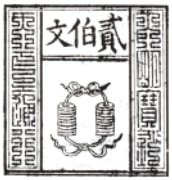 Part II describes Ming dynasty paper money issues and identifies the coins depicted on the 1 kwan bank note of emperor Hung Wu (1378 A.D.)
Part II describes Ming dynasty paper money issues and identifies the coins depicted on the 1 kwan bank note of emperor Hung Wu (1378 A.D.)
Click to download PDF here.
Those Elusive Chinese Mules
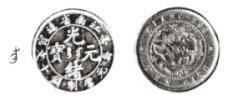 This article examines various possibilities as to how a mule could occur as well as describing some Chinese mules seen by the author.
This article examines various possibilities as to how a mule could occur as well as describing some Chinese mules seen by the author.
Click to download PDF here.
The Use of Bank Notes as an Instrument of Propaganda - Part I
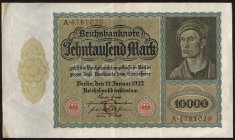 All propaganda is designed to influence public opinion. Such communications take many forms including the subtle use of propaganda both printed and concealed which may be found on a nation's paper currency. Paper money can be a handy tool in the hands of a cunning propagandist, as seen in the examples given in Part I. These examples cover propaganda found on paper money issues from the American Revolution through the occupation of Europe during World War II.
All propaganda is designed to influence public opinion. Such communications take many forms including the subtle use of propaganda both printed and concealed which may be found on a nation's paper currency. Paper money can be a handy tool in the hands of a cunning propagandist, as seen in the examples given in Part I. These examples cover propaganda found on paper money issues from the American Revolution through the occupation of Europe during World War II.
Click to download PDF here.
The Use of Bank Notes as an Instrument of Propaganda - Part II
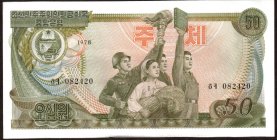 This article examines propaganda used on bank notes during the War in the Pacific against Japan, the Korean War, the Vietnamese War and finally the Gulf War in Iraq.
This article examines propaganda used on bank notes during the War in the Pacific against Japan, the Korean War, the Vietnamese War and finally the Gulf War in Iraq.
Click to download PDF here.
The Scrip Notes of Greenfield Mills
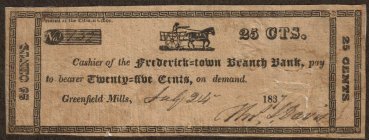 In the 1830s Greenfield Mills was a thriving farm community, replete with its own bank which issued scrip notes for the use of its citizens. Little evidence of Greenfield Mills past exists today, except for the bank notes themselves. When I started my search no one I questioned had ever heard of the place, nor could anyone tell me where it had once been located. A little detective work would ultimately enable the author to determine the answer to this mystery and to learn how the bank failed and why.
In the 1830s Greenfield Mills was a thriving farm community, replete with its own bank which issued scrip notes for the use of its citizens. Little evidence of Greenfield Mills past exists today, except for the bank notes themselves. When I started my search no one I questioned had ever heard of the place, nor could anyone tell me where it had once been located. A little detective work would ultimately enable the author to determine the answer to this mystery and to learn how the bank failed and why.
Click to download PDF here.
Twenty Thousand Rupees Under the Sea
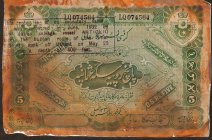 This is the story of the Peninsular and Occidental steamship Egypt which sank in 1922 off the coast of France after colliding with another ship in a heavy fog. Egypt was en-route London to Bombay and carried aboard a tremendous treasure - fifteen tons in silver and gold bars and coins. Unknown to outsiders, she also carried millions of rupees in newly printed bank notes which were destined for the Indian princely state of Hyderabad.
This is the story of the Peninsular and Occidental steamship Egypt which sank in 1922 off the coast of France after colliding with another ship in a heavy fog. Egypt was en-route London to Bombay and carried aboard a tremendous treasure - fifteen tons in silver and gold bars and coins. Unknown to outsiders, she also carried millions of rupees in newly printed bank notes which were destined for the Indian princely state of Hyderabad.
The Italian salvage vessel Artiglio undertook the difficult task of locating the wreck and recovering its cargo. This is a story of sunken treasure and daring salvage work in the face of much adversity, as never before had a salvage attempt been made at such depths. After four years of heartbreaking work over £ 1,000,000 in gold and silver was recovered from 400 feet of water, an unheard of depth for salvage operations of the day.
The numismatic aspects of the treasure recovered is described in detail.
Click to download PDF here.
John Law's Banque Royale and the Mississippi Bubble
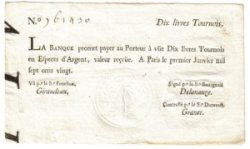 The Banque Royale of 1719 was France's first experiment with a legal tender paper currency. This new money replaced gold and silver coin as a medium of exchange, while at the same time retiring the tremendous state debt accumulated by the late king Louis XIV. The bank's notes were eagerly sought after by Frenchmen anxious to buy shares in the Mississippi Company, a get righ quick scheme devised by the Scottish economist, John Law. The idea was to exploit the riches of France's undeveloped Louisiana Territory through the purchase of shares of stock. The frenzy of speculation which followed created what has become known as the "Mississippi Bubble".
The Banque Royale of 1719 was France's first experiment with a legal tender paper currency. This new money replaced gold and silver coin as a medium of exchange, while at the same time retiring the tremendous state debt accumulated by the late king Louis XIV. The bank's notes were eagerly sought after by Frenchmen anxious to buy shares in the Mississippi Company, a get righ quick scheme devised by the Scottish economist, John Law. The idea was to exploit the riches of France's undeveloped Louisiana Territory through the purchase of shares of stock. The frenzy of speculation which followed created what has become known as the "Mississippi Bubble".
Law was known throughout Europe for his unique economic theories and for his questionable behavior. History has labled him economist, gambler, banker, murderer, royal advisor, rake, adventurer and exile. When the bubble burst a year later many Frenchmen found themselves millionaires, while others were ruined in the crash. Was Law a benefactor or villain? Our story will give you the facts and you can decide.
Click to download PDF here.
The Bank Notes of the French Revolution, Part I (The Royal Assignats)
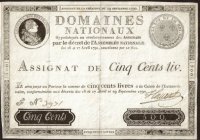
Conditions in France at the close of the eighteenth century were bad both economically and socially. In the predominately agrarian economy crops were failing and tax collections low. Louis XVI's poorly managed monarchy had left France a country of unbalanced budgets, little foreign trade and bad credit - all ingredients for bankruptcy.
The church and aristocrats controlled all the wealth to the detriment of the poor and downtrodden, many of whom were starving. Hard money was being horded. With the peasant class becoming increasingly restless, the stage was set for trouble.
To get the economy moving the National Assembly decided to confiscate church lands for the benefit of the state. Thus the paper currency known as the "assignat" was born. It was initially intended that these notes would be assigned to various parcels of confiscated land until the land could be sold; thereby creating a currency that would stimulate the economy, benefit the poor and forestall more serious trouble. It was not to be, however, as the peasants took matters into their own hands. Their storming of the Basille was the opening shot of the French Revolution.
This is the story of the assignats, first issued under Louis XVI's reign and later continued by the First Republic after the king's execution on the guillotine. Part I will address the royal assignats.
Click to download PDF here.
Bank Notes of the French Revolution, Part II (The Assignats of the First Republic)
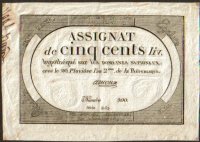
The monarchy of Louis XVI came to an end on 22 September, 1792 when a Republican formed "Convention" created the First Republic. The Convention was anxious to suppress all past references to the monarchy. This desire carried over to France's paper money. Louis XVI's portrait was soon replaced by a new series of livre notes containing Republican symbols and slogans propagandizing the new regime. In 1792-1793 new Republican notes gradually appeared in denominations of 5 to 500 livres. As inflation mounted, the old livre system was replaced by new "franc" notes.
The franc issue of 18 Nivose l'An III ( 1 July 1795) contained values up to 10,000 francs. As inflation ran rampant these notes lost over ninety percent of their value and were, in turn, replaced by "Promesses de Mandats Territoriaux" in 1796. By now the long suffering public had had enough, refusing to accept these new notes in their everyday business. A last ditch effort, using paper money known as "Rescriptions de l' Emprunt Force" also failed within months of it's introduction, whereupon France reverted once again to an entirely specie economy. The First Republic lasted only six years before Napoleon Boneaparte declared himself Emperor Napoleon I of France.
Click to download PDF here.
Foreign Banks in China Part-I
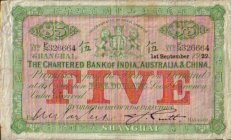
China was not discovered by the West until Marco Polo, the Venetian adventurer, stumbled upon it during his Asian travels of 1271-1295 AD. He was incredulous to discover that the Great Khan possessed the secret of producing money out of paper.
Another 260 years were to pass, however, before the first Europeans settled there. It was not until after the two Opium Wars (1850-1860) that China was truly opened to the West. European merchants were quick to realize the tremendous profits to be made from the export of tea, silks and porcelain which were in great demand in the West. China was forced to pay huge indemnities for the cost of the wars they lost. These payments were enforced through a series of "unequal treaties", where the Western powers gained extraterritorial rights over China. A weak China was divided into "spheres of influence" whereupon each nation set aside Chinese territory for exploitation. Some even set up their own territorial jurisdictions (Hong Kong, Shanghai, Kiaochou) where their citizens lived beyond Chinese law. Before long the need for on-site banking arose. Thus, foreign banking in China was born. The British dominated the field during this early period.
Click to download PDF here.
Foreign Banks in China Part-II
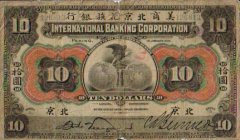
After the two Opium Wars, a weakened China was exploited by additional Western countries, seeking commercial advantage. Foreign powers such as France, Russia, Germany, the United States, Japan and even Belgium and the Netherlands were quick to establish their own "spheres of influence" on Chinese soil.
These countries established commercial banks in the principal industrial cities which then obtained permission from the Chinese government to issue their own paper money. There were no less than twenty foreign owned banks doing business in China during this period. This article examines the foreign banks in China during the late imperial period (1900-1911).
Click to download PDF here.
Foreign Banks in China Part-III
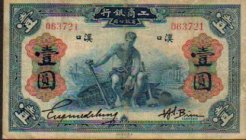
The creation of the Republic of China and the end of World War I brought about a change in Chinese foreign banking. As the old players either disappeared (Germany, Russia) or became immersed in World War I debt payments (Great Britain, France) new players entered the scene. As a result, financial power in China was altered in favor of the newcomers. These new banks were mainly American or Japanese - all established to further commercial ties with the home country. Many were successful joint ventures between Chinese and American businessmen. Part III examines this group of note issuing banks which dominated commercial banking in China from the creation of the republic to the end of World War II.
Click to download PDF here.
Maryland Colonial and Continental Bank Note Issues of the American Revolution
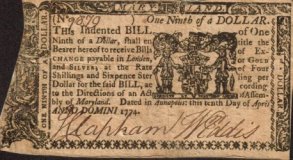
This article will explore the conditions in Colonial Maryland during the years preceeding the revolution as well as the war years leading to independence. Emphasis will be on the various note issues of the colonial and continental governments. .
Click to download PDF here.
Italy's Colonial Empire - A Paper Money Trail
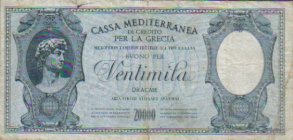
This, the thirty-second in our series of articles on paper money, is the story of how Italy aspired to build a colonial empire of its own - and in large part succeeded.
Being one of the last European countries to unify in 1870, Italy was late in arriving to the "scramble for Africa" wherein other powers, notably Great Britain and France, were expeditiously establishing new colonies on the African continent. Shortly after unification, a wave of nationalism swept across Italy. Italians yearned for the past glory of the Roman Empire which, by 30 BC, had conquered all the lands surrounding the Mediterranean. They felt that much of this old territory was rightfully theirs. When Benito Mussolini came to power in 1922 as Italy's absolute dictator, he played upon this theme. The old Roman notion of Mare Nostrum (Our Sea) almost became a reality. Mussolini was bent upon pushing his 'Greater Italy' all the way across Africa from Tunisia, through Egypt and the Sudan to Italian East Africa on the Indian Ocean before the British stopped him at El Alamein, thus ending Italy's quest for an Italian Empire forever.
Click to download PDF here.
Italian Paper Money Prior to Unification - Part I
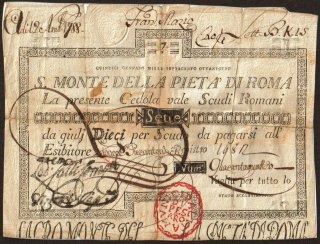
Before unification in 1870, Italy was a collection of kingdoms, duchies and republics, which by and large issued their own paper money. In Part I we will review the bank note issues of these places. Commencing with the kingdom of Piedmont and it's first paper money of 1746 we will in turn discuss the note issues of the Republic of Venice, the Papal States, Lombardy-Venetia, and the kingdoms of Naples and Sicily. Napoleon's invasion of Italy in 1796 changed the map of the peninsula forever. In Part II we will explore these changes, commencing with the notes created during the French occupation.
Click to download PDF here.
Italian Paper Money Prior to Unification - Part II
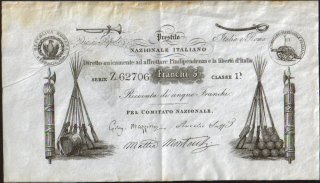
In Part I of this article we examined the bank notes of the various kingdoms, duchies and republics which existed on the Italian peninsula prior to Napoleon's invasion in 1796. Part II examines the political changes brought about by Napoleon's invasion, and the bank note issues created thereby. Subsequent to Napoleon's defeat, we trace the bank notes of the countries re-established by the Treaty of Vienna in 1815. Finally we look at some of the revolutionary movements, which sought independence from the kings, dukes, and grand-dukes who ruled Italy during the revolution of 1848. Lastly we address the ultimate success of the revolutionaries, which brought about independence and the establishment of the Kingdom of Italy.
Click to download PDF here.
Imperial Currency of the Tai'ping Rebellion-Part I
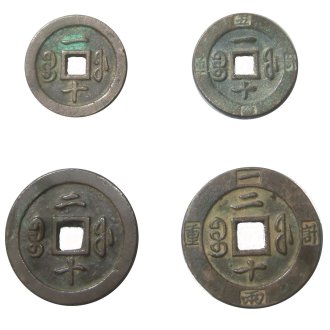
Part I is entitled Emperior Hsien Feng’s Multiple Cash Coins. This article deals with the first attempt to raise money to fight the Tai’ping insurgency. For two thousand years the only circulating currency used in China had been single one cash coins typically bound together in strings of 500 or 1000 cash in order to facilitate commerce. The rebellion changed all this. No longer were strings of coins sufficient to conduct business, thereby necessitating the creation of multiple cash.
Click to download PDF here.
Imperial Chinese Currency of the Tai'ping Rebellion - Part II
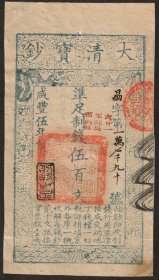
The Ch'ing dynasty paper money is known as Ta Ch'ing Pao Chao. These were cash notes which were forced upon an unwilling peasantry in order to pay for the war, after a four hundred year absence of a paper currency in China.
Click to download PDF here.
Imperial Chinese Currency of the Tai'ping Rebellion - Part III
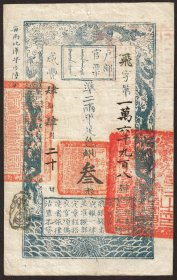
The silver tael notes of the Board of Revenue were used to finance the defense of imperial China.
Click to download PDF here.
Bank Notes of the Government of Malta

The island nation of Malta has had a colorful past. Occupied by many peoples throughout history, it was not until the Napoleonic Wars that Malta sought protection as a British crown colony, maintaining that status until independence in 1964. During World War II Malta, due to its strategic location at the crossroads of the Mediterranean, became the most heavily bombed area of the war. Overcoming overwhelming odds, Malta survived on extraordinary heroism and sheer willpower.
Malta's bank notes are equally colorful, being created to meet the needs of early commerce, and later, to cope with emergencies brought about by World Wars I and II. Post World War II produced Malta's first permanent "Government of Malta" currency. With independence, these issues became obsolete when notes of the Central Bank of Malta were issued.
Click to download PDF here.